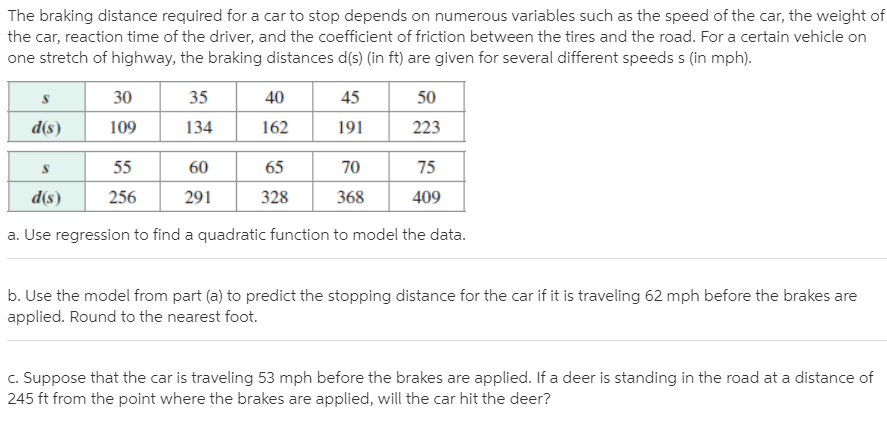The braking distance required for a car to stop depends on numerous variables such as the speed of the car, the weight of the car, reaction time of the driver, and the coefficient of friction between the tires and the road. For a certain vehicle on one stretch of highway, the braking distances d(s) (in ft) are given for several different speeds s (in mph). 30 35 40 45 50 d(s) 109 134 162 191 223 55 60 65 70 75 256 291 328 368 409 (s)P a. Use regression to find a quadratic function to model the data. b. Use the model from part (a) to predict the stopping distance for the car if it is traveling 62 mph before the brakes are applied. Round to the nearest foot. c. Suppose that the car is traveling 53 mph before the brakes are applied. If a deer is standing in the road at a distance of 245 ft from the point where the brakes are applied, will the car hit the deer?
The braking distance required for a car to stop depends on numerous variables such as the speed of the car, the weight of the car, reaction time of the driver, and the coefficient of friction between the tires and the road. For a certain vehicle on one stretch of highway, the braking distances d(s) (in ft) are given for several different speeds s (in mph). 30 35 40 45 50 d(s) 109 134 162 191 223 55 60 65 70 75 256 291 328 368 409 (s)P a. Use regression to find a quadratic function to model the data. b. Use the model from part (a) to predict the stopping distance for the car if it is traveling 62 mph before the brakes are applied. Round to the nearest foot. c. Suppose that the car is traveling 53 mph before the brakes are applied. If a deer is standing in the road at a distance of 245 ft from the point where the brakes are applied, will the car hit the deer?
Algebra & Trigonometry with Analytic Geometry
13th Edition
ISBN:9781133382119
Author:Swokowski
Publisher:Swokowski
Chapter4: Polynomial And Rational Functions
Section4.3: Zeros Of Polynomials
Problem 67E
Related questions
Question

Transcribed Image Text:The braking distance required for a car to stop depends on numerous variables such as the speed of the car, the weight of
the car, reaction time of the driver, and the coefficient of friction between the tires and the road. For a certain vehicle on
one stretch of highway, the braking distances d(s) (in ft) are given for several different speeds s (in mph).
30
35
40
45
50
d(s)
109
134
162
191
223
55
60
65
70
75
256
291
328
368
409
(s)P
a. Use regression to find a quadratic function to model the data.
b. Use the model from part (a) to predict the stopping distance for the car if it is traveling 62 mph before the brakes are
applied. Round to the nearest foot.
c. Suppose that the car is traveling 53 mph before the brakes are applied. If a deer is standing in the road at a distance of
245 ft from the point where the brakes are applied, will the car hit the deer?
Expert Solution
This question has been solved!
Explore an expertly crafted, step-by-step solution for a thorough understanding of key concepts.
This is a popular solution!
Trending now
This is a popular solution!
Step by step
Solved in 5 steps with 5 images

Recommended textbooks for you

Algebra & Trigonometry with Analytic Geometry
Algebra
ISBN:
9781133382119
Author:
Swokowski
Publisher:
Cengage

College Algebra
Algebra
ISBN:
9781305115545
Author:
James Stewart, Lothar Redlin, Saleem Watson
Publisher:
Cengage Learning

Functions and Change: A Modeling Approach to Coll…
Algebra
ISBN:
9781337111348
Author:
Bruce Crauder, Benny Evans, Alan Noell
Publisher:
Cengage Learning

Algebra & Trigonometry with Analytic Geometry
Algebra
ISBN:
9781133382119
Author:
Swokowski
Publisher:
Cengage

College Algebra
Algebra
ISBN:
9781305115545
Author:
James Stewart, Lothar Redlin, Saleem Watson
Publisher:
Cengage Learning

Functions and Change: A Modeling Approach to Coll…
Algebra
ISBN:
9781337111348
Author:
Bruce Crauder, Benny Evans, Alan Noell
Publisher:
Cengage Learning


College Algebra (MindTap Course List)
Algebra
ISBN:
9781305652231
Author:
R. David Gustafson, Jeff Hughes
Publisher:
Cengage Learning

Algebra and Trigonometry (MindTap Course List)
Algebra
ISBN:
9781305071742
Author:
James Stewart, Lothar Redlin, Saleem Watson
Publisher:
Cengage Learning